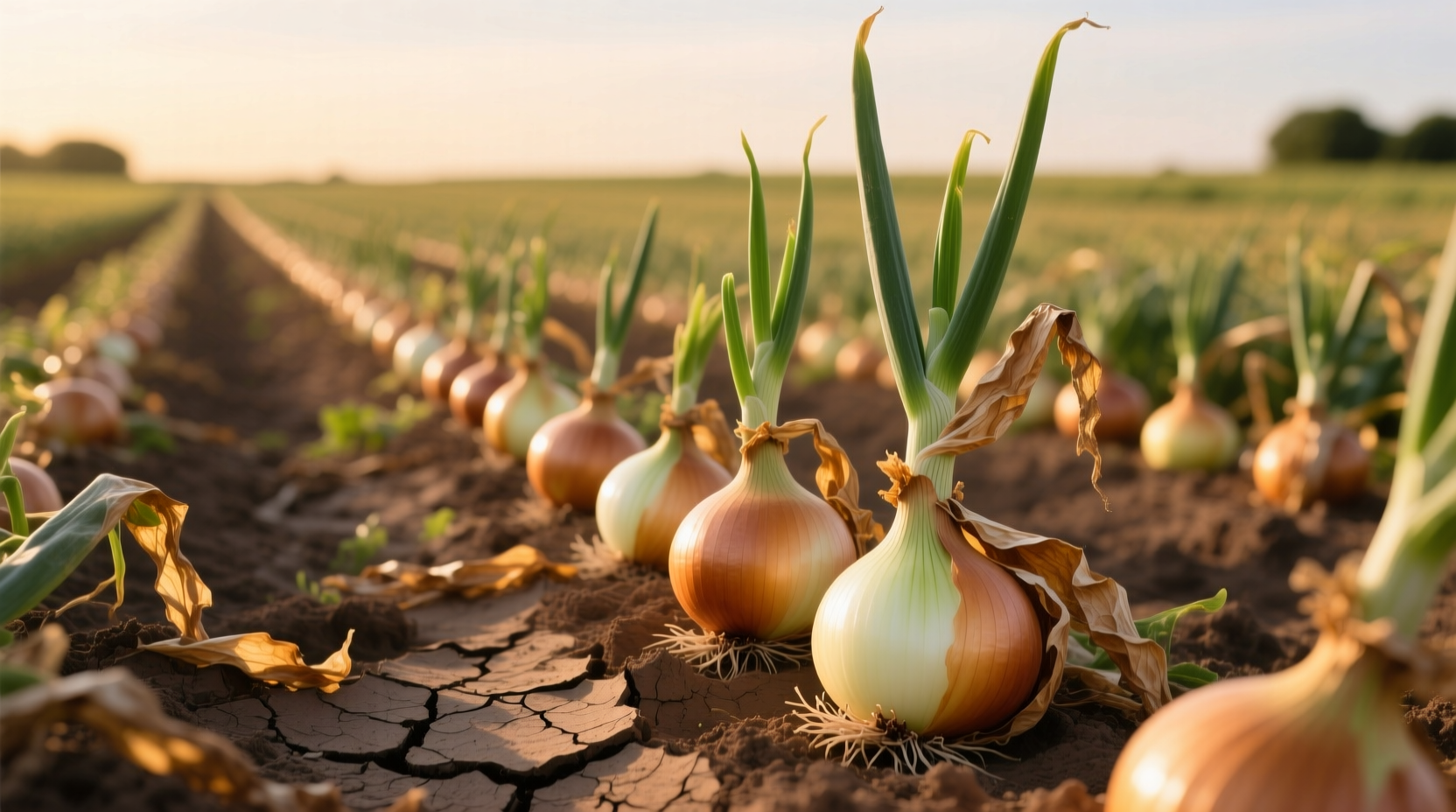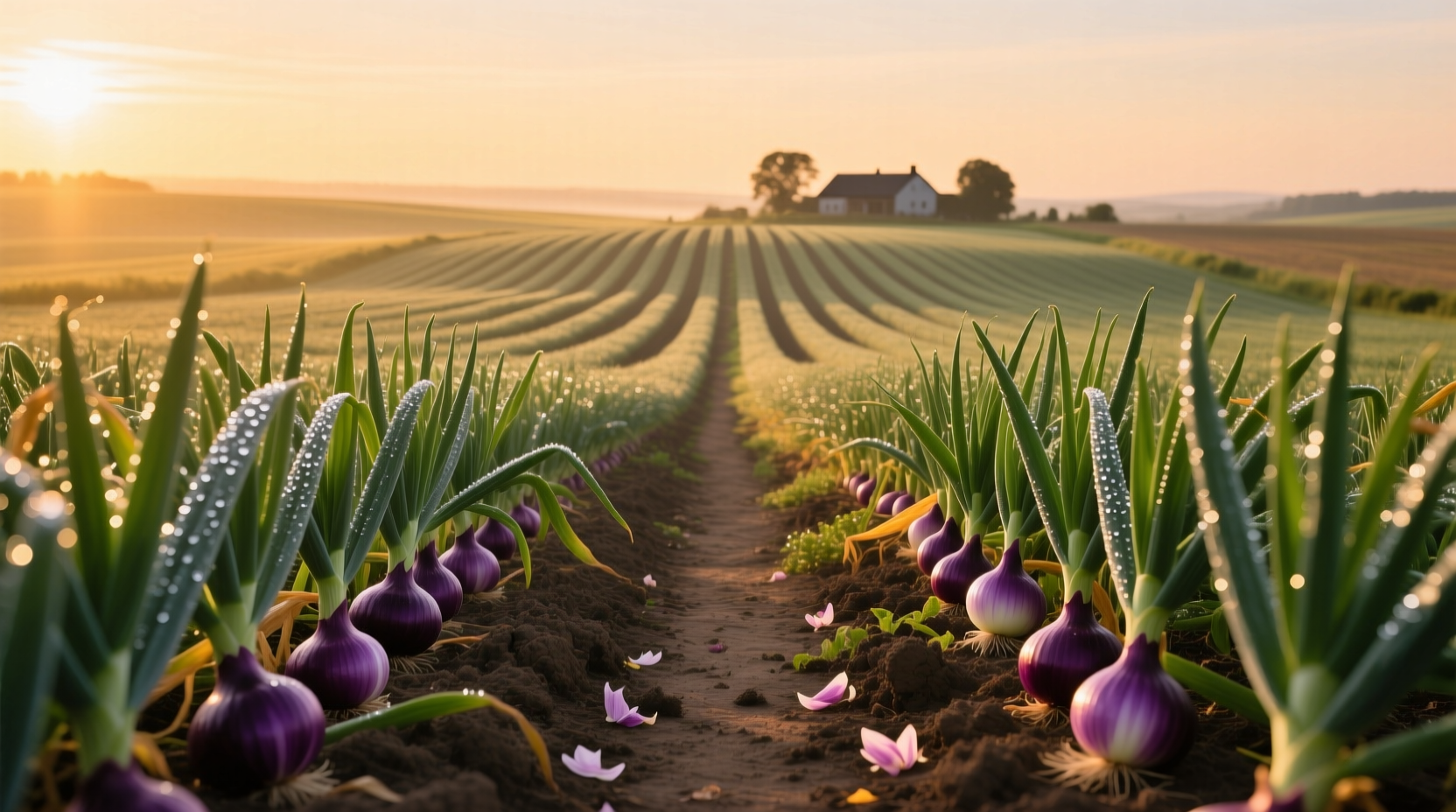Discover exactly how professional growers transform bare soil into productive onion fields yielding 25-40 tons per acre. This guide reveals the science-backed practices separating successful commercial onion production from crop failures, whether you're managing a small garden plot or planning large-scale cultivation.
Understanding Onion Field Fundamentals
Onion fields represent one of the most technically demanding vegetable production systems. Unlike backyard gardening, commercial onion cultivation requires precise management of soil composition, water delivery, and growth timing. The difference between a profitable harvest and total crop loss often comes down to decisions made during the first 30 days after planting.
Commercial onion production follows a strict biological timeline. According to the USDA Agricultural Research Service, onions develop through three critical phases: root establishment (0-21 days), bulb initiation (45-60 days), and bulb maturation (75-120 days). Missing these windows by even a week can reduce yields by 15-20%.

Planning Your Commercial Onion Field
Successful onion farming begins with strategic planning that considers your specific geographic conditions. The University of California's Agriculture and Natural Resources program emphasizes that soil preparation makes or breaks onion crops. Ideal onion field soil contains 2-5% organic matter with excellent drainage characteristics.
| Onion Variety Type | Day Length Requirement | Best Growing Regions | Harvest Timeframe |
|---|---|---|---|
| Short-Day Varieties | 10-12 hours | South of 36°N latitude | February-April |
| Intermediate-Day Varieties | 12-14 hours | 32°-40°N latitude | April-May |
| Long-Day Varieties | 14-16 hours | Above 36°N latitude | July-August |
This variety comparison from Cornell University's Cooperative Extension demonstrates why matching onion types to your geographic location proves critical. Planting long-day varieties in southern regions results in premature bolting, while short-day types fail to bulb properly in northern climates.
Planting Techniques for Maximum Yield
Professional onion field establishment requires precision planting methods that home gardeners often overlook. Commercial growers achieve optimal spacing through either direct seeding or transplanting systems:
- Direct seeding: Uses precision planters placing seeds 0.5-1 inch deep at 15-25 seeds per foot, later thinned to 2-4 inch spacing
- Transplant systems: Involves growing seedlings in greenhouse conditions for 8-10 weeks before field transplanting at 1-2 inch spacing
- Set planting: Uses small pre-grown bulbs planted 1-2 inches deep at 2-6 inch spacing (most common for home growers)
The California Farmland Information Center reports that transplant systems typically yield 20-30% higher production than direct seeding but require significant infrastructure investment. For small-scale operations, set planting offers the most accessible entry point despite slightly lower yields.
Field Maintenance: Water and Nutrient Management
Onion fields demand precise irrigation scheduling that follows crop development stages. During the critical bulb formation phase (60-90 days), onions require consistent moisture without saturation. The optimal irrigation schedule follows this pattern:
- Establishment phase: 0.25 inches daily
- Leaf growth phase: 0.35 inches every 3 days
- Bulb formation: 0.5 inches every 4 days
- Maturation phase: Gradual reduction to 0.25 inches every 7 days
Nitrogen management proves equally crucial. Excessive nitrogen during bulb formation creates thick necks prone to rot, while insufficient nitrogen limits bulb size. Soil testing every 30 days helps maintain the ideal 120-150 lb/acre nitrogen range throughout the growing season.
Harvesting and Storage Protocols
Timing the onion harvest requires careful observation of natural indicators. Commercial growers watch for these maturation signs:
- 60-75% of tops naturally falling over
- Neck tissue becoming soft and pithy
- Outer bulb scales taking on characteristic variety color
After lifting, proper curing transforms field-harvested onions into storage-ready bulbs. The USDA recommends a two-stage curing process: 7-10 days at 75-80°F with high humidity, followed by 14-21 days at 65-70°F with lower humidity. This process reduces moisture content from 88% to 82%, dramatically extending shelf life.
Common Onion Field Challenges and Solutions
Onion fields face numerous threats that require proactive management:
Pest Management
Thrips represent the most economically damaging pest, costing US growers over $100 million annually according to USDA APHIS. Integrated pest management combines:
- Biological controls (predatory mites)
- Soil moisture management (thrips thrive in dry conditions)
- Strategic insecticide applications during critical growth stages
Disease Prevention
White rot and pink root fungi can devastate onion fields. Prevention strategies include:
- 4-year crop rotation with non-Allium crops
- Soil solarization in warmer climates
- Resistant varieties like 'Santana' for white rot
Weather Adaptation
Unexpected rainfall during harvest can cause immediate losses. Successful growers implement:
- Bedded field systems for improved drainage
- Weather monitoring with 72-hour harvest windows
- Emergency drying facilities for wet harvests
How much space does an onion field need for commercial production?
Commercial onion production typically requires minimum 1-acre plots for economic viability, though some specialty growers operate successfully on 0.5-acre plots. The USDA reports that most commercial onion farms range from 10-500 acres, with optimal efficiency occurring at 20-100 acre operations where equipment utilization balances fixed costs.
What's the average yield per acre in a well-managed onion field?
According to USDA 2024 agricultural statistics, well-managed onion fields produce 25-40 tons per acre for fresh market onions. Storage variety yields tend to be higher (35-45 tons/acre), while specialty sweet onions typically yield 20-30 tons/acre. Yield potential depends significantly on variety selection, soil quality, and regional climate conditions.
How long does it take to grow onions from planting to harvest?
Onion growing seasons range from 90-120 days depending on variety and growing conditions. Short-day varieties mature in 90-100 days, intermediate-day in 100-110 days, and long-day varieties require 110-120 days. The University of Georgia Extension notes that cooler temperatures can extend these timelines by 10-15 days, while optimal warm conditions may shorten them slightly.
What's the most profitable onion variety for commercial fields?
Yellow storage onions like 'Yellow Granex' consistently show the highest profitability for commercial fields, with average returns of $2,500-$3,500 per acre according to USDA Economic Research Service data. However, specialty sweet onions (Vidalia, Walla Walla) can generate higher per-pound prices when grown in designated regions with proper certification, though they require more precise growing conditions and have shorter market windows.











 浙公网安备
33010002000092号
浙公网安备
33010002000092号 浙B2-20120091-4
浙B2-20120091-4